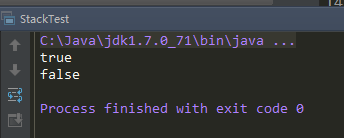栈和队列:
面试的时候,栈和队列经常会成对出现来考察。本文包含栈和队列的如下考试内容:
(1)栈的创建
(2)队列的创建
(3)两个栈实现一个队列
(4)两个队列实现一个栈
(5)设计含最小函数min()的栈,要求min、push、pop、的时间复杂度都是O(1)
(6)判断栈的push和pop序列是否一致
1. 栈的创建:
我们接下来通过链表的形式来创建栈,方便扩充。
代码实现:
1 public class Stack {
2
3 public Node head;
4 public Node current;
5
6
7 //方法:入栈操作
8 public void push(int data) {
9 if (head == null) {
10 head = new Node(data);
11 current = head;
12 } else {
13 Node node = new Node(data);
14 node.pre = current;//current结点将作为当前结点的前驱结点
15 current = node; //让current结点永远指向新添加的那个结点
16 }
17 }
18
19 public Node pop() {
20 if (current == null) {
21 return null;
22 }
23
24 Node node = current; // current结点是我们要出栈的结点
25 current = current.pre; //每出栈一个结点后,current后退一位
26 return node;
27
28 }
29
30
31 class Node {
32 int data;
33 Node pre; //我们需要知道当前结点的前一个结点
34
35 public Node(int data) {
36 this.data = data;
37 }
38 }
39
40
41 public static void main(String[] args) {
42
43 Stack stack = new Stack();
44 stack.push(1);
45 stack.push(2);
46 stack.push(3);
47
48 System.out.println(stack.pop().data);
49 System.out.println(stack.pop().data);
50 System.out.println(stack.pop().data);
51 }
52
53 }
入栈操作时,14、15行代码是关键。
运行效果:
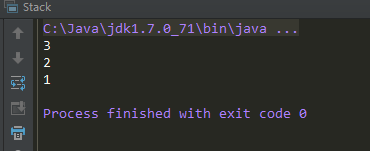
2. 队列的创建:
队列的创建有两种形式:基于数组结构实现(顺序队列)、基于链表结构实现(链式队列)。
我们接下来通过链表的形式来创建队列,这样的话,队列在扩充时会比较方便。队列在出队时,从头结点head开始。
代码实现:
入栈时,和在普通的链表中添加结点的操作是一样的;出队时,出的永远都是head结点。
1 public class Queue {
2 public Node head;
3 public Node curent;
4
5 //方法:链表中添加结点
6 public void add(int data) {
7 if (head == null) {
8 head = new Node(data);
9 curent = head;
10 } else {
11 curent.next = new Node(data);
12 curent = curent.next;
13 }
14 }
15
16 //方法:出队操作
17 public int pop() throws Exception {
18 if (head == null) {
19 throw new Exception("队列为空");
20 }
21
22 Node node = head; //node结点就是我们要出队的结点
23 head = head.next; //出队之后,head指针向下移
24
25 return node.data;
26
27 }
28
29
30 class Node {
31 int data;
32 Node next;
33
34 public Node(int data) {
35 this.data = data;
36 }
37 }
38
39
40 public static void main(String[] args) throws Exception {
41 Queue queue = new Queue();
42 //入队操作
43 for (int i = 0; i < 5; i++) {
44 queue.add(i);
45 }
46
47 //出队操作
48 System.out.println(queue.pop());
49 System.out.println(queue.pop());
50 System.out.println(queue.pop());
51
52 }
53 }
运行效果:
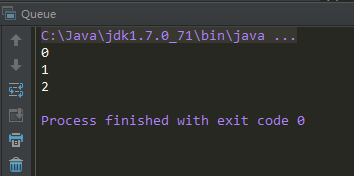
3. 两个栈实现一个队列:
思路:
栈1用于存储元素,栈2用于弹出元素,负负得正。
用栈1负责来添加操作,用栈2来实现弹出操作;如果栈2里面有元素,直接弹出,没有元素,判断栈1,栈1没有元素,返回错误;栈1有元素,则将栈1里面的元素都弹到栈2,然后从栈2中弹出元素。
完整版代码实现:
1 import java.util.Stack;
6 public class Queue {
7
8 Stack<Integer> stack1 = new Stack<Integer>();
Stack<Integer> stack2 = new Stack<Integer>();
10 /**
11 * 每次添加都往栈1里面添加
12 * @param node 待插入队列中元素
13 */
14 public void push(int node){
15 stack1.push(node);
16 }
17
18 /**
19 * 每次弹出都从栈2里面弹出
20 * @return
*/
public int pop(){
if(!stack2.isEmpty())
return stack2.pop();
if(stack1.isEmpty())
return -1;
else{
while(!stack1.isEmpty())
stack2.push(stack1.pop());
return stack2.pop();
}
}
37 public static void main(String[] args) throws Exception {
38 Queue queue = new Queue();
39 queue.push(1);
40 queue.push(2);
41 queue.push(3);
42
43 System.out.println(queue.pop());
44
45 queue.push(4);
46
47 System.out.println(queue.pop());
48 System.out.println(queue.pop());
49 System.out.println(queue.pop());
50
51 }
52
53 }
运行效果:
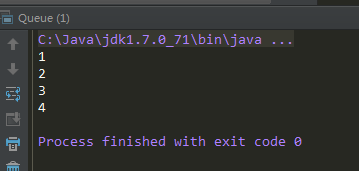
4. 两个队列实现一个栈:
思路:
将1、2、3依次入队列一, 然后最上面的3留在队列一,将下面的2、3入队列二,将3出队列一,此时队列一空了,然后把队列二中的所有数据入队列一;将最上面的2留在队列一,将下面的3入队列二。。。依次循环。
代码实现:
1 import java.util.ArrayDeque;
2 import java.util.Queue;
3
7 public class Stack {
8
Queue queue1 = new LinkedList();
Queue queue2 = new LinkedList();
11
12 /**
* 添加元素的时候向不为空的队列中添加元素
* @param node
*/
public void push(int node){
if(queue2.isEmpty())
queue1.add(node);
if(queue1.isEmpty())
queue2.add(node);
}
/**
* 删除元素的时候先将不为空的队列的前n-1个元素添加到另外一个队列中,然后将第n个元素删除
* @return
*/
public int poll(){
int temp = -1;
if(!queue2.isEmpty()){
while(!queue2.isEmpty()){
temp = (int) queue2.poll();
if(!queue2.isEmpty())
queue1.add(temp);
}
return temp;
}else if(!queue1.isEmpty()){
while(!queue1.isEmpty()){
temp = (int) queue1.poll();
if(!queue1.isEmpty())
queue2.add(temp);
}
return temp;
}else
return -1;
}
36
37 public static void main(String[] args) throws Exception {
38 Stack stack = new Stack();
39
40 stack.push(1);
41 stack.push(2);
42 stack.push(3);
43
44 System.out.println(stack.pop());
45 System.out.println(stack.pop());
46 stack.push(4);
47 }
48 }
运行效果:

5. 设计含最小函数min()的栈,要求min、push、pop、的时间复杂度都是O(1)。min方法的作用是:就能返回是栈中的最小值。【微信面试题】
普通思路:
一般情况下,我们可能会这么想:利用min变量,每次添加元素时,都和min元素作比较,这样的话,就能保证min存放的是最小值。但是这样的话,会存在一个问题:如果最小的元素出栈了,那怎么知道剩下的元素中哪个是最小的元素呢?
改进思路:
这里需要加一个辅助栈,用空间换取时间。辅助栈中,栈顶永远保存着当前栈中最小的数值。具体是这样的:原栈中,每次添加一个新元素时,就和辅助栈的栈顶元素相比较,如果新元素小,就把新元素的值放到辅助栈和原栈中,如果新元素大,就把元素放到原栈中;出栈时,如果原栈跟辅助栈元素相同,都弹出,否则只弹出原栈栈顶元素
完整代码实现:
1 import java.util.Stack;
2
6 public class MinStack {
7
8
Stack stack = new Stack(); //定义用来存储数据的栈
Stack minStack = new Stack(); //定义用来存储最小数据的栈
/**
* 添加数据,首先是往stack栈中添加
* 如果最小栈minStack为空,或者栈顶的元素比新添加的元素要大,则将新元素也要添加的辅助栈中
* @param node
*/
public void push(int node) {
stack.push(node);
if(minStack.isEmpty() || ((int)minStack.peek()) >= node){
minStack.push(node);
}
}
/**
* 如果stack空,直接返回
* 如果stack不为空,得到栈顶元素,同时将栈顶元素弹出
* 如果最小栈的栈顶元素与stack弹出的元素相等,那么最小栈也要将其弹出
*/
public void pop() {
if(stack.isEmpty())
return;
int node = (int)stack.peek();
stack.pop();
if((int)minStack.peek() == node){
minStack.pop();
}
}
/**
* 查看栈顶元素
* @return
*/
public int top() {
return (int)stack.peek();
}
/**
* 查看栈的最小元素
* @return
*/
public int min() {
return (int)minStack.peek();
}
40 public static void main(String[] args) throws Exception {
41 MinStack stack = new MinStack();
42 stack.push(4);
43 stack.push(3);
44 stack.push(5);
45
46 System.out.println(stack.min());
47 }
48 }
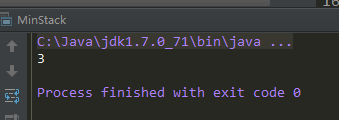
6、判断栈的push和pop序列是否一致:
通俗一点讲:已知一组数据1、2、3、4、5依次进栈,那么它的出栈方式有很多种,请判断一下给出的出栈方式是否是正确的?
例如:
数据:
1、2、3、4、5
出栈1:
5、4、3、2、1(正确)
出栈2:
4、5、3、2、1(正确)
出栈3:
4、3、5、1、2(错误)
完整版代码:
1 import java.util.Stack;
2
3 /**
4 * Created by smyhvae on 2015/9/9.
5 */
6 public class StackTest {
7
8 /**
* 首先将特殊情况,边界情况进行排除掉
* 然后定义一个循环,开始遍历第一个数组,将遍历的每个对象往stack里面添加,
* 如果遇到栈不为空且stack顶元素与第二个数组对应位置相等的情况,就弹栈,
* 同时第二个数组指针后移
* 最后判断栈是否为空
* @param pushA 入栈队列
* @param popA 出栈队列
* @return
*/
public boolean isPopOrder(int[] pushA, int[] popA){
if(pushA == null || popA == null || pushA.length == 0 || popA.length == 0 || pushA.length != popA.length)
return false;
if(pushA.length == popA.length && pushA.length == 1)
return pushA[0] == popA[0];
Stack stack = new Stack();
int i = 0;
int j = 0;
int len = pushA.length;
while(i < len && j < len){
stack.push(pushA[i]);
++i;
while(!stack.isEmpty() && (int)stack.peek() == popA[j]) {
stack.pop();
++j;
}
}
return stack.isEmpty();
}
24
25 public static void main(String[] args) {
26
27 Stack<Integer> stack = new Stack<Integer>();
28
29 int[] data1 = {1, 2, 3, 4, 5};
30 int[] data2 = {4, 5, 3, 2, 1};
31 int[] data3 = {4, 5, 2, 3, 1};
32
33 System.out.println(sequenseIsPop(data1, data2));
34 System.out.println(sequenseIsPop(data1, data3));
35 }
36 }
代码比较简洁,但也比较难理解,要仔细体会。
运行效果:
